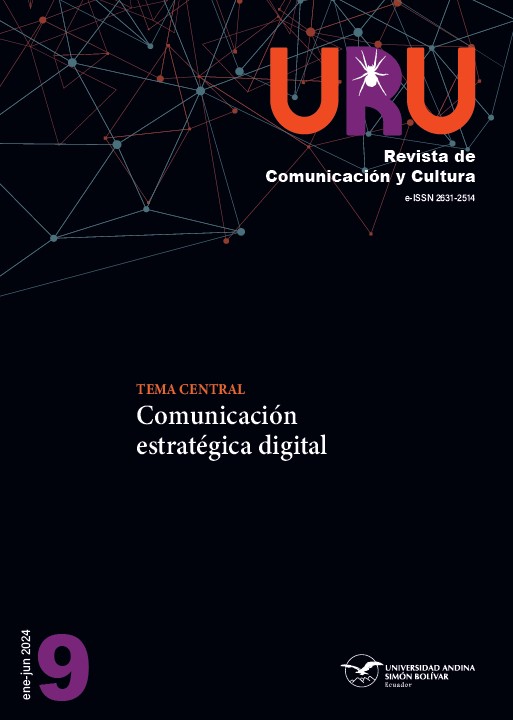Appropriation of Art in Advertising: I Am Not Sure Goya Would Have Liked This
DOI:
https://doi.org/10.32719/26312514.2024.9.8Keywords:
Advertising, art, appropriationism, recontextualization, advertising campaigns, cultural context, cultural property presentation, communication ethicsAbstract
The present study contrasts the relationship between art and advertising within the appropriationism movement. Demonstrating that advertising takes advantage of cultural and artistic assets to contextualize it, make them their own in order to make a profit. Methodologically, ten in-depth interviews with experts are carried out, four advertisers: Luis Bassat, Rafa Fortis, Daniel Cuadrado Romera and Lara Martín Ortega. Confronted with seven artists from different disciplines: Santiago Bellido, Manuel Tamariz, Julio Falagán, Belén González Díaz, Carlos Trigueros Mori, José Francisco Vaquero Mata and Chema Alonso. Starting from the campaign + 1.5ºC Changes everything of WWF launched at the 2019 Climate Summit, it re-uses artworks made by Patinir, Goya, Soroya or Velazquez ceded by. Prado Museum. It is analysed in questions about appropriationism, the impact of art on advertising campaigns. If they consider this reuse as plagiarism of cultural property, if it directly affects the exercise of the profession, and the legal protection of artistic works. It is concluded that advertising makes use of art. Positively valuing appropriationism for educational work and dissemination of culture. However, its primary use as a sales technique is noted. Legally, the resolution of infringements of intellectual property rights is left in the hands of professional deontology. Diluting the artistic limits in which all creative communication is inspired, specially in persuasive messages.
Downloads
References
Aumente, María del Pilar. 1999. “Arte y publicidad: Breves notas en torno a sus relaciones”. Área Cinco 6: 5-28. https://tinyurl.com/yvw5lxlj.
Bassat, Luis. 1994. El libro rojo de la publicidad. Madrid: Debolsillo.
Córdova, Edmundo, José Rivera, Laura Medina y Rosa Carpio. 2019. “Construcción del imaginario social desde una perspectiva publicitaria en medios sensacionalistas”. IROCAMM. International Review of Communication and Marketing Mix 2 (2): 49-57. https://tinyurl.com/4bkc2e97. DOI: https://doi.org/10.12795/IROCAMM.2019.v02.i02.06
Cotán, Almudena. 2016. “El sentido de la investigación cualitativa”. Escuela Abierta 19: 33-48. https://doi.org/10.29257/EA19.2016.03. DOI: https://doi.org/10.29257/EA19.2016.03
Daza, Sandra. 2014. “Investigación-creación: Un acercamiento a la investigación en las artes”. Horizontes Pedagógicos 11 (1). https://tinyurl.com/yoohqz4g.
ES. 1978. Constitución española. Boletín Oficial del Estado 311, 29 de diciembre. https://bit.ly/3ymCrqV.
—. 1985. Ley 16/1985, de 25 de junio, del Patrimonio Histórico Español. Boletín Oficial del Estado 155, 29 de junio. https://bit.ly/31Stt98.
—. 1996. Real Decreto Legislativo 1/1996, de 12 de abril, por el que se aprueba el texto refundido de la Ley de Propiedad Intelectual, regularizando, aclarando y armonizando las disposiciones legales vigentes sobre la materia. Boletín Oficial del Estado 97, 24 de abril. https://bit.ly/30lO05f.
—. 2014. Ley 21/2014, de 4 de noviembre, por la que se modifica el texto refundido de la Ley de Propiedad Intelectual, aprobado por Real Decreto Legislativo 1/1996, de 12 de abril, y la Ley 1/2000, de 7 de enero, de Enjuiciamiento Civil. Boletín Oficial del Estado 268, 5 de noviembre. https://bit.ly/31L2BYM.
Esgueva, Victoria, y Nuria Nicolau. 2019. “Apropiacionismo en el arte, la legitimidad de la imagen sustraída”. En IV Congreso Internacional de Investigación en Artes Visuales ANIAV 2019: Imagen [N] Visible, editado por Elías Pérez, Emilio Martínez y Fabiane Silva, 226-31. Valencia, ES: Universitat Politècnica de València. https://tinyurl.com/nhjumtvx.
García, Ana. 2015. “Lazos, apropiaciones y transgresiones de estrategias de la iconosfera publicitaria en las artes visuales: Una perspectiva crítica desde el arte español actual”. Imafronte 24: 279-300. https://bit.ly/3DPQre1.
González, Rodrigo. 1997. “Arte y publicidad: Acotaciones a un matrimonio irreverente, pero eficaz”. Documentación Social 107: 53-82. https://tinyurl.com/2x9a27kg.
—. 2018. “Collage, apropiacionismo y propiedad intelectual”. Visual. 25 de enero. https://tinyurl.com/yklq8t7z.
Heredero, Olga, y Miguel Ángel Chaves. 2018. “Publicidad con arte: El efecto de transfusión del arte como estrategia de branding para las marcas premium”. Revista Comunicación 1 (16): 55-75. https://tinyurl.com/yc6cajy2. DOI: https://doi.org/10.12795/Comunicacion.2018.i16.04
Juaneda, Emma, Cristina Olarte y Miriam Pérez. 2018. “Alternativas a la publicidad tradicional: Lovisual, un evento de éxito”. AdResearch ESIC. International Journal of Communication Research 17 (17):72-89. https://tinyurl.com/5ecnx5dz. DOI: https://doi.org/10.7263/adresic-017-03
Martín Prada, Juan. 2014. Otro tiempo para el arte: Cuestiones y comentarios sobre el arte actual. Valencia, ES: Sendemà.
Martínez Barragán, Carlos. 2012. “Metodología cualitativa aplicada a las bellas artes”. Revista Electrónica de Investigación, Docencia y Creatividad 1: 46-62. https://tinyurl.com/rjaak3z9.
Moral, Javier, y Fernando Canet. 2018. “Dialogismo y prácticas apropiacionistas en el videoarte contemporáneo”. Palabra Clave 21 (4): 1164-88. https://doi.org/10.5294/pacla.2018.21.4.9. DOI: https://doi.org/10.5294/pacla.2018.21.4.9
Vikingo, Pedro. 2013. “Apropiacionismo. Agustín Fernández Mallo”. Video de Vimeo. https://bit.ly/31Wbdvl.
Downloads
Published
How to Cite
Issue
Section
License
Copyright (c) 2024 Uru: Revista de Comunicación y Cultura

This work is licensed under a Creative Commons Attribution-NonCommercial-ShareAlike 4.0 International License.
ASSIGNMENT OF RIGHTS, DECLARATION OF CONFLICT OF INTEREST AND DISSEMINATION
The authors who publish in this journal accept the following conditions:
- Authors retain copyright and grant the journal the right of first publication, with the work registered under the Creative Commons Attribution-NonCommercial-ShareAlike 4.0 License, which allows sharing, adapting and attributing the work (see: Open Access Policies).
- Authors can make other independent and additional contractual agreements for the distribution of the article published in this journal (e.g., include it in an institutional repository or publish it in a book) as long as they expressly indicate that the article was published for the first time in Uru: Revista de Comunicación y Cultura. In the case of reproduction, a note similar to the following must be included: This text was originally published in the journal Uru: Revista de Comunicación y Cultura N ° -, year of publication.
- Authors are encouraged to publish their work on the Internet (e.g. on institutional or personal pages) in the final version published by Uru: Revista de Comunicaicón y Cultura as it may lead to a wider and faster dissemination of the published work.








